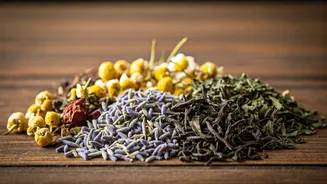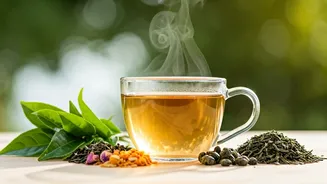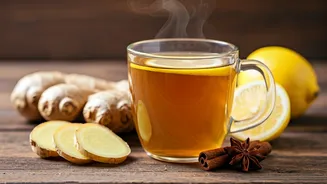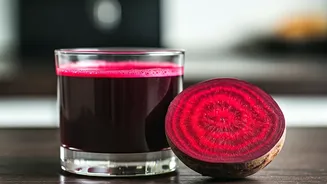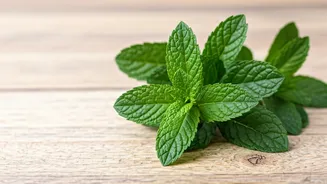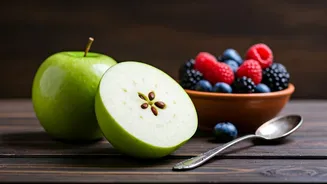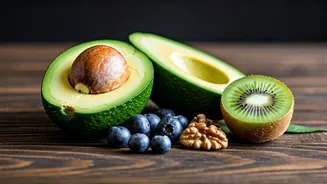Chamomile's Gentle Touch
Chamomile tea, a well-loved beverage worldwide, has long been recognized for its calming qualities. It is commonly used to soothe anxiety and promote relaxation,
which can indirectly aid in alleviating tension headaches. The tea contains compounds that interact with the brain's receptors, promoting relaxation. To prepare chamomile tea, steep a teaspoon of dried chamomile flowers in hot water for about 5-10 minutes. Drinking this tea, particularly before bed, might improve sleep quality and consequently reduce the frequency or severity of headaches. Furthermore, chamomile's anti-inflammatory properties can assist in lessening the pain associated with headaches. However, it's wise to be cautious if you have allergies to plants in the daisy family, as chamomile can trigger similar reactions. Start with a small amount to assess how your body responds.
Peppermint's Refreshing Relief
Peppermint tea is another effective choice, celebrated for its refreshing and pain-relieving abilities. The menthol present in peppermint has a muscle-relaxing effect, which can ease tension headaches and migraine symptoms. Many individuals find that inhaling the steam from peppermint tea can provide almost immediate relief from congestion, a frequent accompanying symptom of headaches. To use peppermint for headache relief, steep fresh or dried peppermint leaves in hot water for approximately 5-7 minutes. You can also apply peppermint oil, diluted in a carrier oil like coconut or almond oil, to your temples and forehead. However, exercise caution if you have heartburn, as peppermint may worsen symptoms in some individuals. The stimulating scent of peppermint can also aid in mental clarity, which is a significant advantage when battling a headache or migraine.
Lavender's Calming Influence
Lavender tea is renowned for its calming properties. It is often used to alleviate anxiety, stress, and insomnia, which can contribute to the onset of headaches and migraines. The aroma of lavender is a natural mood booster that can reduce stress levels, potentially reducing headache frequency. To prepare lavender tea, steep a teaspoon of dried lavender buds in hot water for about 5-10 minutes. You can also inhale the steam from the tea or apply a few drops of lavender essential oil (diluted in a carrier oil) to your temples. Lavender can be particularly beneficial for headaches induced by stress or tension. Be cautious if you're taking sedatives, as lavender might intensify their effects. Its gentle and floral aroma can also provide a sense of relaxation.
Ginger's Anti-inflammatory Power
Ginger tea is an excellent remedy for headaches and migraines, thanks to its potent anti-inflammatory properties. Ginger can alleviate the nausea often associated with migraines and reduce the inflammation that triggers headache pain. It works by blocking the production of inflammatory compounds in the body. To prepare ginger tea, steep fresh ginger slices in hot water for around 10-20 minutes, or use ginger tea bags. Adding a touch of honey or lemon can also improve the taste and add to the health benefits. Ginger is particularly useful for migraines that include nausea and vomiting. Some studies suggest ginger is as effective as common migraine medications without the side effects. It’s a good choice for managing both pain and associated symptoms.
Feverfew's Headache Fighter
Feverfew tea has a long history of use for managing migraines. Feverfew contains compounds that can reduce the inflammation and constriction of blood vessels that contribute to migraine headaches. To make feverfew tea, steep the dried leaves in hot water for approximately 5-10 minutes. However, because feverfew can have a bitter taste, it is sometimes taken in capsule form or mixed with other herbs. Feverfew is particularly known for reducing the frequency and severity of migraine attacks over time. It is not generally advised for pregnant women. Before starting feverfew, consult with your healthcare provider to ensure it's safe for you, especially if you’re taking other medications.
Willow Bark’s Natural Aspirin
White willow bark tea contains salicin, a compound similar to aspirin, which is a well-known pain reliever. Salicin is converted into salicylic acid in the body, which helps to alleviate headaches and reduce inflammation. To prepare willow bark tea, steep the bark in hot water for about 10-15 minutes. It can be useful for various types of headaches, especially those linked to inflammation. However, individuals with allergies to aspirin should avoid it. Willow bark can also thin the blood, so consult a doctor if you take blood-thinning medications. The tea provides a gentler approach to pain management compared to over-the-counter medications.
Butterbur's Migraine Remedy
Butterbur tea is a less common but effective option for migraine prevention. It has been shown to reduce both the frequency and severity of migraines. However, butterbur contains pyrrolizidine alkaloids (PAs), which can be toxic to the liver. It’s essential to use butterbur products that are PA-free. To use butterbur, follow the dosage recommendations provided on the supplement packaging or prescribed by your healthcare provider. This herb might be particularly beneficial for those experiencing frequent migraines. Given its potential side effects and interactions with other medications, consult your doctor before using butterbur. Despite the caution, it can be a significant addition to natural headache remedies.
